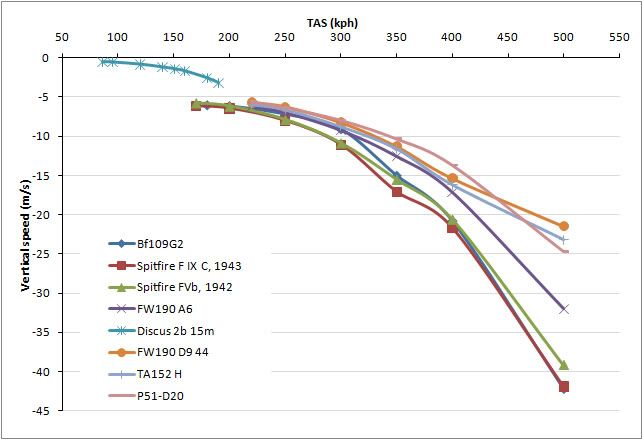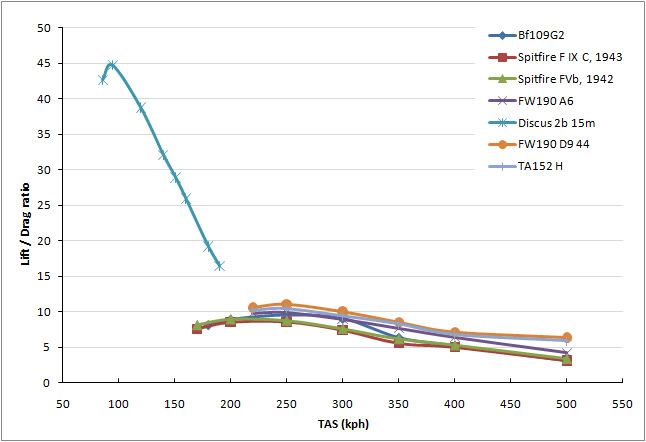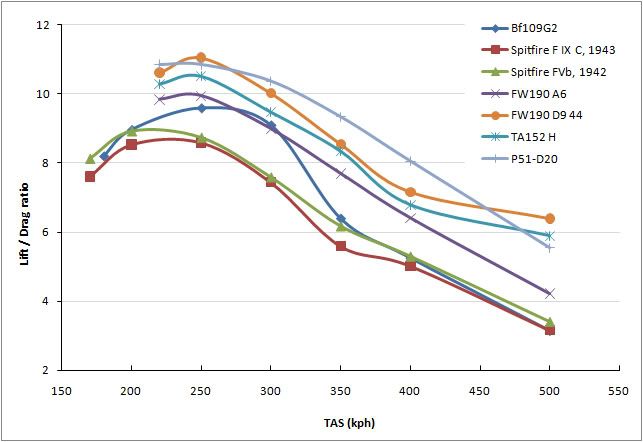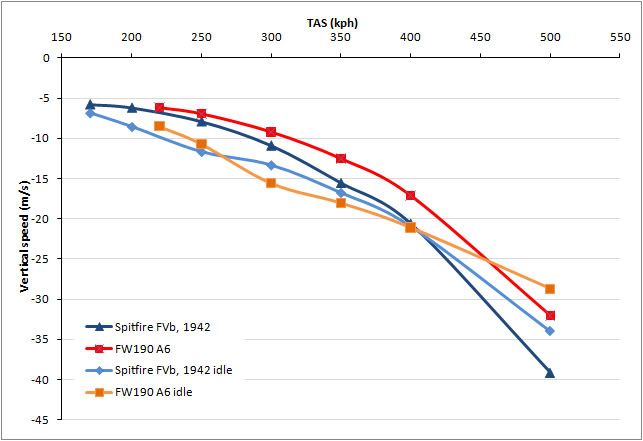
 |
|
|||||||
| IL-2 Sturmovik The famous combat flight simulator. |
 |
|
|
Thread Tools | Display Modes |
|
#1
|
|||
|
|||
|
Hi folks! I've done some flight testing to find out the lift to drag ratios (L/D) of some of our planes in IL2FB 4.10.
The lift to drag ratio is the ratio between lift and total drag in steady-state flight at a certain speed (no turning involved). L/D ratios describe how aerodynamically clean (or dirty) a plane is. Also, the L/D ratio changes drastically with speed. Planes reach their best climb and their best power off glide at the speed with the highest L/D ratio. To dissect the steady state aerodynamics without interference from the engine i flew the tests in an engine off condition, 50 % fuel, prop pitch = 0, closed rads. I flew a set speed (TAS) in a steady glide. In the replay i recorded the time needed to glide from 500m right into the sea (crimea map), and that gave me the average vertical speed (in m/s). From the constant speed and the average vertical speed i could calculate the L/D ratio, which is the distance flown divided by the lost altitude (500m). If we were to compare the Spit MkVb, Spit MkIX, P51-D20, FW190 A6, FW190 D9, BF109 G2, TA152 H, what plane do you think is the best glider? Here are the polar curves, showing the vertical speed needed in order to keep the given air speeds. For comparison i've plotted the polar of a very popular modern glider that we have in our soaring club, the Discus 2b. It's minium sink speed in still air is 0.56m/s at 85kph.  And here are the calculated L/D ratios. Yes the Discus reaches a distance of 45km starting 1km above ground  Let's have a closer look at warbids only. Both spits cluster together nicely, and the plots for spits and 109 are almost identical at higher speeds. Owing to their clean designs the Mustang, D9 and TA152 are the best of the bunch. At 500 kph their L/D is twice that of the spits and of the 109. What is weird is that the L/D ratio of the D9 and TA152 decreases at a slower rate between 400 and 500kph. Almost as if a drag generating device had been removed (think of flaps, rads, feathered prop). You see similar effects in gliders when they set their flaps to a negative setting at high speeds. However, i have no idea how this dent in the D9 and TA L/D plots comes about. The 109 plot shows a hump at 250 and 300 kph, which i've tested repeatedly. I can't explain it either, it seems not to be related to slats, as they were fully retracted (at least optically on the 3d model) at those speeds.  To investigate what effects props have i've compared polar curves flown with engine off vs idle engine, prop pitch 0%. As you see, an idling engine creates more drag at slower speeds, and less drag at 500kph. Go figure.  Any constructive feedback is greatly appreciated. Maybe you guys have a better understanding of the observed effects. S! |
|
#2
|
|||
|
|||
|
Nice testing, interesting results.
With the exception of the 250/300 km/h points on the 109, the light planes are the worse gliders. |
|
#3
|
|||
|
|||
|
The fact that these things can be sensibly tested, measured and compared at all is a great testament to IL2's flight model.
|
|
#4
|
|||
|
|||
|
In one of the hyperlobby servers I once glided some 25 km in an FW-190 after losing my engine over the enemy airfield. I wouldn't have made it home in many other planes!
It would be interesting to see where the Go-229 sits on some of these graphs. It seems to be able to glide twice as far as anything else. |
|
#5
|
|||
|
|||
|
A nice set of tests, which seem to confirm that the IL-2 flight model is fairly accurate in general principles, if not necessarily in particular cases. One word of caution though - there seem to be some 'ground effect' factors that can kick in, which could possibly be distorting the results slightly - you might de better to test from say 1000m to 500m, rather than from 500m to sea level.
|
|
#6
|
|||
|
|||
|
Ground effect is a decrease in induced drag and only relevant in very low-level flight up to an altitude equaling about the plane's wingspan. BTW i've specifically tested whether ground effect is present in IL2FB some time ago, the results were a clear no. Which is OK, the effect is not THAT big or relevant in RL except during flareout. No, i stand by my experimental setup, it's clean.
|
|
#7
|
|||
|
|||
|
Quote:
|
|
#8
|
|||
|
|||
|
Anyone got a graph that compares wing area and weight to vertical speed and TAS for a theoretical plane?
That would be nice to see. For example, it would show the extent to which ww2 planes would have better energy retention if they had more weight. i.e. what's the optimum fuel loadout in a P51 for the best energy retention or the highest wingload to v-speed ratio. Last edited by Letum; 02-13-2011 at 08:42 AM. |
|
#9
|
|||
|
|||
|
Quote:
|
|
#10
|
|||
|
|||
|
Cool Andy, good to hear they've implemented ground effect. I did my ground effect tests in a way very similar to yours, but before 4.08.
Taking into account that real ground effect is only there between 0-10m, it has no significant effect on the average sink rate measured over 500 m of altitude. I've also experienced "the other" ground effect. I reproducibly experience it as a sudden turbulence when i pass above a coastline ingame. However, it had no effect on this test, as i flew above water at all times. I even have all tracks, really boring stuff though |
 |
|
|